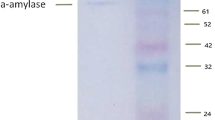Abstract
Purification, characterization and biochemical properties of α-amylase from post harvest Bangladeshi Potato (Solanum tuberosum L.) were investigated. The α-amylase was purified by successive chromatography on DEAE and CM-cellulose columns with a yield of 24.24%. SDSPAGE showed a molecular weight of 44 kDa for the enzyme that contain 2.8% sugar. The enzyme lost total activity in the presence of the chelating agent EDTA, confirming it was an α-type amylase. The enzyme displayed optimum activity at pH 7.2 and 37°C, with an apparent Km value of 0.26% using starch as its substrate. The enzyme was strongly inhibited by Cu2+, Fe2+ and Zn2+; moderately by Li+, Hg+ and Cd2+; and slightly by Ag+, K+, Mn2+ and Mg2+. Conversely, Fe3+ and Na+ appreciably enhanced activity, while adding calcium ion nearly doubled enzyme activity. In addition, the activity of α-amylase gradually decreased with increasing concentrations of urea. Thus, potato α-amylase is an attractive target for study to better understand the structure-function relationships of α-amylases.
Similar content being viewed by others
References
Abe R, Chib AY, and Nakajima T (2002) Characterization of the functional module responsible for the low temperature optimum of rice α-amylase (Amy 3E). Biol Bratis 57, 197–202.
Bailey KM, Phillips IDJ, Pitt D (1978) The roles of buds and gibberellin in dormancy and the mobilization of reserve materials in potato tubers. Ann Bot 41, 649–657.
Baker JE (1991) Purification and partial characterization of α-amylase allozymes from the lesser grain borer Rhyzopertha dominica. Insect Biochem 21, 303–311.
Beaupoil-Abadie B, Raffalli M, Cozzone P, and Marchis-Mouren G (1973) Determination of the carbohydrate content of porcine pancreatic amylase. Biochim Biophys Acta 297, 436–441.
Beers E and Duke S (1990) Characterization of α-amylase from shoots and cotyledons of pea (Pisum sativum L.) seedlings. Plant Physiol 92, 1154–1159.
Berbezy P, Legendre L, and Maujean A (1996) Purification and characterization of α-amylase from vine inter-nodes. Plant Physiol Biochem 34, 353–361.
Boyer E and Ingle M (1972) Extracellular alkaline amylase from a Bacillus species. J Bacteriol, 110, 992–998.
Cottrell J E, Duffus CM, Paterson L, Mackay GR, Allisom MJ, and Bain H (1993) The effect of storage temperature on reducing sugar concentration and the activities of three amylolytic enzymes in tubers of the cultivated potato, Solanum tuberosum L. Potato Res 36, 107–117.
Davies HV, Ross HA (1987) Hydrolytic and phosphorolytic enzyme activity and reserve mobilization in sprouting tubers of potato (Solanum tuberosum L.). J Plant Physiol 126, 387–396.
Dreier W, Schnarrenberger C, and Bomer T (1995) Lightand stress-dependent enhancement of amylolytic activities in white and green barley leaves; α-Amylases are stress-induced proteins. J Plant Physiol 145, 342–348.
Dubois M, Gilles KA, Hamilton JK, Rebers DA, and Smith F (1956) Colorimetric methods for the determination of sugars and related substances. Analy Chem 28, 350–352.
Laemmli UK (1970) Cleavage of structural protein during the assembly of the head of bacteriophage T4. Nature 227, 680–685.
Landerman KA, Davis BR, Krutzsch HC, Lewis MS, Griko YV, Privalov PL, and Anfinsen CB (1993) The purification and characterization of an extremely thermostable α-amylase from the hyperthermophilic archaebacterium Pyrococcus furiosus. J Biol Chem 266, 24394–24401.
Lee SK, Kim YB, and Ji GE (1997) Purification of amylase secreted from Bifid bacterium adolescentis. J Appl Microbiol 83, 267–272.
Lin LL, Chyau CC, and Hsu WH (1998) Production and properties of a raw-starch-degrading amylase from the thermophilic and alkaliphilic Bacillus sp. TS-23. Biotec App Biochem 28, 61–68.
Lizotte PA, Henson CA, and Duke SH (1990) Purification and characterization of pea epicotyl β-amylase. Plant Physiol 92, 615–621.
Lowry OH, Rosebrough NJ, Farr AL, and Randall RJ (1951) Protein measurement with the Folin phenol reagent. J Bio Chem 193, 265–275.
Maarel MJECV, Veen BV, Uitdehaag JCM, Leemhuis H, and Dijkhuizen L (2002) Properties and applications of starch-converting enzymes of the α-amylase family. J Biotech 94, 137–155.
Miller GL (1959) Use of dinitrosalicylic acid reagent for the determination of reducing sugar. Analy Chem 31, 426–429.
Moranelli F, Yaguchi M, Calleja GB, and Nasim A (1987) Purification and characterization of the extracellular α-amylase activity of the yeast Schwanniomyces alluvius. Biochem Cell Bio 65, 899–908.
Nakakuki T, Azuma K, and Kajnuma K (1984) Action patterns of various exo-amylases and the anomeric configurations of their products. Carbohyd Res 128, 297–310.
Nielsen AV, Christensen T, Bojko M, and Marcussen J (1997) Purification and characterization of β-amylase from leaves of potato (Solamum tuberosum). Physiol Plantarum 99, 190–196.
Noman ASM, Hoque MA, Sen PK, and Karim MR (2006) Purification and some properties of α-amylase from post-harvest Pachyrhizus erosus L. tuber. Food Chem 99, 444–449.
Nowak J (1977) Biochemical changes in stored potato tubers with different rest periods. II. Influence of the storage temperature and isopropyl phenylcarbamates on enzyme activities. J Plant Physiol 81, 125–140.
Ranwala AP and Miller WB (2000) Purification and characterization of an endoamylase from tulip (Tulipa gesneriana L.) bulbs. Physiol Plantarum 109, 388–395.
Saito N (1973) A thermophilic extracellular α-amylase from Bacillus licheniformis. Arch Biochem Biophys 155, 290.
Savchenko A, Vielle C, Kang S, and Zeikus G (2002) Pyrococcus Furiosus α-amylase is stabilized by calcium and zinc. Biochemistry 41, 6193–6201.
Shaw JF and Ou-Lee TM (1984) Simultaneous purification of α-amylase and β-amylase from germinated rice seeds and some factors affecting activities of the purified enzymes. Bota Bull Aca Sinica 25, 197–204.
Steup M (1988) Starch degradation. In Biochemistry of Plants, Preiss J (ed.), 14, pp. 255–296. Academic Press, San Diego, U.S.A.
Toralballa G and Eitingon M (1967) Action of urea and certain other amide reagents on crystalline porcine pancreatic amylase. Arch Biochem Biophys 119, 519–525.
Wegrzyn T and MacRae E (1995) Alpha-amylase and starch degradation in kiwifruit. J Plant Physiol 147, 19–28.
Witt W and Sauter JJ (1996) Purification and properties of a starch granule-degrading α-amylase from potato tubers. J Exp Bot 47, 1789–1795.
Author information
Authors and Affiliations
Corresponding author
Rights and permissions
About this article
Cite this article
Sarker, G.K., Hasan, S., Nikkon, F. et al. Purification, characterization, and biochemical properties of α-amylase from potato. J. Korean Soc. Appl. Biol. Chem. 53, 8–14 (2010). https://doi.org/10.3839/jksabc.2010.002
Received:
Accepted:
Published:
Issue Date:
DOI: https://doi.org/10.3839/jksabc.2010.002




